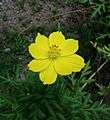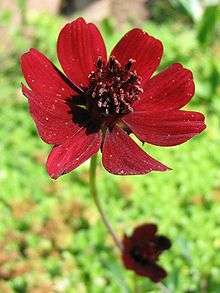Cosmos (plant)
Cosmos is a genus, with the same common name of cosmos, consisting of flowering plants in the sunflower family.[3][4]
| Cosmos | |
|---|---|
 | |
| Cosmos bipinnatus | |
| Scientific classification | |
| Kingdom: | Plantae |
| Clade: | Tracheophytes |
| Clade: | Angiosperms |
| Clade: | Eudicots |
| Clade: | Asterids |
| Order: | Asterales |
| Family: | Asteraceae |
| Tribe: | Heliantheae |
| Genus: | Cosmos Cav.[1] |
| Synonyms[2] | |
| |
Description
Cosmos are herbaceous perennial plants or annual plants growing 0.3–2 m (1 ft 0 in–6 ft 7 in) tall. The leaves are simple, pinnate, or bipinnate, and arranged in opposite pairs. The flowers are produced in a capitulum with a ring of broad ray florets and a center of disc florets; flower color is very variable between the different species. The genus includes several ornamental plants popular in gardens. Numerous hybrids and cultivars have been selected and named.
Distribution
Cosmos species are native to scrub and meadowland in Mexico where most of the species occur, the United States, as far north as the Olympic Peninsula in Washington, Central America, and to South America as far south as Paraguay. One species, C. bipinnatus, is naturalized across much of the eastern United States and eastern Canada.[5] It is also widespread over the high eastern plains of South Africa, where it was introduced via contaminated horsefeed imported from Argentina during the Anglo-Boer War.
Species
.jpg)

- Accepted species[2]
- Cosmos atrosanguineus (Hook.) Voss
- Cosmos bipinnatus Cav.
- Cosmos carvifolius Benth.
- Cosmos caudatus Kunth
- Cosmos concolor Sherff
- Cosmos crithmifolius Kunth
- Cosmos dahlioides
- Cosmos deficiens (Sherff) Melchert
- Cosmos herzogii Sherff
- Cosmos intercedens Sherff
- Cosmos jaliscensis Sherff
- Cosmos juxtlahuacensis Panero & Villaseñor
- Cosmos landii Sherff
- Cosmos linearifolius (Sch.Bip.) Hemsl.
- Cosmos longipetiolatus Melchert
- Cosmos mattfeldii Sherff
- Cosmos mcvaughii Sherff
- Cosmos microcephalus Sherff
- Cosmos modestus Sherff
- Cosmos montanus Sherff
- Cosmos nelsonii B.L.Rob. & Fernald
- Cosmos nitidus Paray
- Cosmos ochroleucoflorus Melchert
- Cosmos pacificus Melchert
- Cosmos palmeri B.L.Rob.
- Cosmos parviflorus (Jacq.) Pers.
- Cosmos peucedanifolius Wedd.
- Cosmos pringlei B.L.Rob. & Fernald
- Cosmos purpurens Sherff
- Cosmos purpureus (DC.) Benth. & Hook.f. ex Hemsl.
- Cosmos scabiosoides Kunth
- Cosmos schaffneri Sherff
- Cosmos sessilis Sherff
- Cosmos sherffii Melchert
- Cosmos steenisiae Veldkamp
- Cosmos sulphureus Cav.
Gallery
 Yellow cosmos flower in Kerala, India
Yellow cosmos flower in Kerala, India- Yellow-orange cosmos, Kerala, India
 Cosmos and old house in Japan
Cosmos and old house in Japan- Cosmos flower in Korea
 Cosmos atrosanguineus, the chocolate cosmos
Cosmos atrosanguineus, the chocolate cosmos
References
- "Genus Cosmos Cav". Germplasm Resources Information Network. United States Department of Agriculture. 1998-09-07. Archived from the original on 2015-09-24. Retrieved 2011-02-13.
- Flann, C (ed) 2009+ Global Compositae Checklist
- Cavanilles, Antonio José. 1791. Icones et Descriptiones Plantarum 1(1): 9–10, pl. 14
- Tropicos, Cosmos Cav.
- Biota of North America Program 2013 county distribution maps
External links
| Wikimedia Commons has media related to Cosmos (Asteraceae). |
| Wikispecies has information related to Cosmos |
